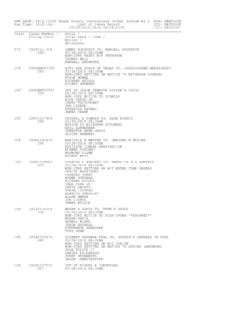Transcription of The Story Of Enrique Esparza - Bexar Genealogy
1 Courtesy Story Of Enrique EsparzaSan Antonio ExpressSaturday, Nov. 22, 1902 Says That He Was In The Siege Of The AlamoIs Seventy-Four Years Old And Tells An Interesting Tale Of ThatMemorable Massacre And Scenes Leading Up To ItSince the death of Se ora[AndreaCasta n] CandelariaVillanueva, several years ago at the age of 113 [95]there is butone person alive who claims to have been in the siege of theAlamo. That person is Enrique Esparza , now 74 years old, who,firm -stepped, clear-minded and clear-eyed, bids fair to live tothe age of the woman who for so long shared honors with Esparza , who tells one of the most interestingstories ever narrated, works a truck garden on Nogalitos streetbetween the southern Pacific Railroad track andthe San Pedrocreek. Here he lives with the family of his son, Victor morning he is up before daybreak and helps load the wagonswith garden stuff that is to be taken up town to is a farmer of experience and contributes verymaterially to the success of the beautiful five acres garden, ofwhich he is the joint claims of Enrique Esparza have been known among thosefamiliar with the historical work done by the Daughters of theRepublic, an organization which has taken great interest ingetting first-hand information of the period of TexasIndependence, the old man was not available up to about fiveyears ago, for the reason that he resided on his farm in Atascosacounty.
2 This accounts for the fact that he is not well enoughknown to be included in the itinerary when San Antonians areproudly doing the town with their tells a straight Story . Although he is a Mexican,his gentleness and unassuming frankness are like the typical oldTexan. Everysyllable he speaks to, uttered with confidence andin his tale, he frequently makes digressions, going into detailsof relationship of early families of San Antonio and showing atenacious memory. At the time of the fight of the Alamo he was 8years father was a defender, and his father's ownbrother, an assailant of the Alamo. He was a witness of hismother's grief, and had his own grief, at the slaughter in whichhis father was included. As he narrated to a reporter the eventsin which he was so deeply concerned, his voice several timeschoked and he could not proceed for emotion.
3 While he has a fairidea of English, he preferred to talk in Story Of Enrique EsparzaCourtesy s StoryMy father, Gregorio Esparza , belonged to Benavides'company, in the Americanarmy," said Esparza , "and I think it wasin February, 1836, that the company was ordered to Goliad when myfather was ordered back alone to San Antonio, for what I don'tknow . When he got here there were rumors that Santa Ana was onthe way here, and many residents sent their families away. Oneof my father's friends told him that he could have a wagon andteam and all necessary provisions for a trip, if he wanted totake his family away. There were six of us besides my father, mymother, whose name wasAnita, my eldest sister, myself and threeyounger brothers, one a baby in arms. I was 8 years father decided to take the offer and move the family toSan was ready, when one morning, Mr.
4 , who was godfather to my youngest brother, came to ourhouse on North FloresStreet, just above where the PresbyterianChurchnow is, and told my mother to tell my father when he camein that Santa Ana had come.(Northeast corner of Houston and Streets.)When my father came my mother asked him what he would know the Americans had the Alamo, which had been fortified afew months before by General[Martin]Cos. Well, I'm going to the fort" my father said. Well, if pop goes, I am going along, and the whole familytoo. It took the whole day to move and an hour before sundown wewere inside the fort. There was a bridge over the river aboutwhere Commerce street crosses it, and just as we got to it wecould her Santa Anna's drums beating on Milam Square, and just aswe were crossing the ditch going into the fort Santa Anna firedhis salute on Milam were a few other families who had gone in.
5 A [Juana Navarro]and her sister, a Mrs. Victoriana, and afamily of several girls, two of whom Iknew afterwards, Mrs.[Susanna]Dickson, Mrs. Juana Melton[Juana Francisca Losoya], aMexican woman who had married an American, also a woman namedConcepci n Losoya and her son, Juan, who was a little older first thing I remember after getting inside the fortwas seeing Mrs. Melton making circles on the ground with anumbrella. I had seen very few umbrellas. While I was walkingaround about dark I went near a man named[Antonio]Fuentes whoThe Story Of Enrique EsparzaCourtesy talking at a distance with a soldier. When thelatter gotnear me he said to Fuentes:"Did you know they had cut the water off?"The fort was built around a present Hugo-Schmeltzer building is part of it.
6 I remember the main entrancewas on the south side of the large enclosure. The quarters werenot in the church, but on the south side of the fort, on eitherside of the entrance, and were part of the convent. There was aditch of running water back of the church and another along thewest side of Alamo Plaza. We couldn't get to thelatter ditch asit was under fire and it was the other one that Santa Anna cutoff . The next morning after we had gotten in the fort I saw themen drawing water from a well that was in the convent yard. Thewell was located a little south of the center of the square. Idon't know whether it is there now or the first night a company of which my father was onewent out and captured some prisoners. One of them was a Mexicansoldier, and all through the siege, he interpreted the buglecalls on theMexican side, and in this way the Americans knowabout the movements of the the first day there was fighting.
7 The Mexicans had acannon somewhere near where Dwyer Avenue now is, and everyfifteen minutes they dropped a shot into the roof of the Alamo had been taken off and the south sidefilled up with dirt almost to the roof on that side so that therewas a slanting embankment up which the Americans could run andtake positions. During the fight I saw numbers who were shot inthe head as soon as they exposed themselves from the roof. Therewere holes made in the walls of the fort and the Americanscontinually shot from these also. We also had two cannon, one atthe main entrance and one at the northwest corner of the fortnear the post office. The cannon were seldom CrockettI remember Crockett. He was a tall, slim man, with blackwhiskers. He was always at the head.
8 The Mexicans called himDon Benito. The Americans said he was Crockett. He would oftenco me to the fire and warm his hands and say a few words to us inthe Spanish also remember hearing the names ofTravis and Bowie mentioned, but I never saweither of them that Iknow the first few days I remember that a messenger camefrom somewhere with word that help was coming. The Americanscelebrated it by beating the drums and playing on the flute. ButThe Story Of Enrique EsparzaCourtesy about seven days fighting there was an armistice of threedays and during this time Don Benito had conferences every daywith Santa Anna. Badio, the interpreter, was a close fired of myfather, and I heard him tell my father in the quarters that SantaAnna had offered to let the Americans go with their lives if theywould surrender, but the Mexicans would be treated as the armistice my father told my mother she hadbetter take the children and go, while she could do so my mother said: N o!
9 If you're going to stay, so am I. Iftheykill one they can kill us all. Only one person went out during the armistice, a womannamed Trinidad Benito, or Crockett, as the Americans called him,assembled the men on the last day and told them Santa Anna'sterms, but none of them believed that any one who surrenderedwould get out alive, so theyall said as they would have to dieany how they would fight it fighting began again and continued everydayand nearlyevery night. One night there was music in the Mexican camp andthe Mexican prisoner said it meant that reinforcements hadarri then had another messenger who got through the lines,saying that communication had been cut off and the promisedreinforcements could not be Last NightOn the last night my father was not out, but he and mymother were sleeping together in headquarters.
10 About 2 o'clockin the morning there was a great shooting and firing at thenorthwest corner of the fort, and I heard my mother say: Gregorio, the soldiers have jumped the fight'sbegun. He got up and picked up his arms and went into the never saw him again. My uncle told me afterwards that SantaAnna gave him permission to get my father's body, and that hefound it where the thick of the fight had could hear the Mexican officers shouting to the men tojump over, and the men were fighting so close that we could hearthem strike each other. It was so dark that we couldn't seeanything, and the families that were in the quarters just huddledup in the corners. My mother's children were near her. Finallythey began shooting through the dark into the room where we boy who was wrapped in a blanket in one corer was hit andThe Story Of Enrique EsparzaCourtesy The Mexicans fired into the room for at least fifteenminutes.




